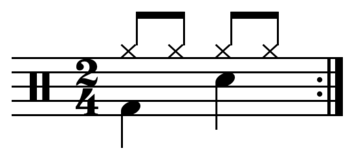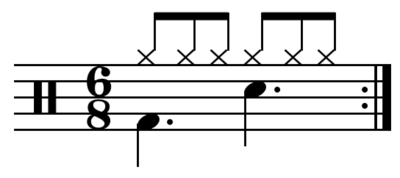Duple and quadruple meter


Duple meter (or duple metre, also known as duple time) is a musical metre characterized by a primary division of 2 beats to the bar, usually indicated by 2 and multiples (simple) or 6 and multiples (compound) in the upper figure of the time signature, with 2
2 (cut time), 2
4, and 6
8 (at a fast tempo) being the most common examples. Though it must, the upper figure being divisible by two does not of itself indicate duple metre; for example, a time signature of 6
8 usually indicates compound duple metre though it may locally emphasize simple triple, such as the famous example of Leonard Bernstein's song "America" from West Side Story.


4
4 is the most common time signature in rock, blues, country, funk, and pop.[1] Although jazz writing has become more adventurous since Dave Brubeck's seminal Time Out, the majority of jazz and jazz standards are still in straight four time.
Duple time is common in many styles including the polka, notorious for its obvious "oom-pah" duple feel. Compare to the waltz.
Tunes in duple metre tend to be less lyrical and more martial than those in triple. For example, the British national anthem, "God Save the Queen," is in triple metre, as is that of the United States, "The Star-Spangled Banner," but this is highly unusual for national anthems, as almost all are in march time.
Binary measure refers to common time.
Quadruple meter
Quadruple meter (or quadruple metre, also known as quadruple time) is a musical meter characterized in modern practice by a primary division of 4 beats to the bar,[2] usually indicated by 4 in the upper figure of the time signature, with 4
4 (common time, also notated as ![]() ) being the most common example.
) being the most common example.
Sources
- ↑ Schroedl, Scott (2001). Play Drums Today!, p.42. Hal Leonard. ISBN 0-634-02185-0.
- ↑ Anon. 2001. "Quadruple Time". The New Grove Dictionary of Music and Musicians, second edition, edited by Stanley Sadie and John Tyrrell. London: Macmillan Publishers.